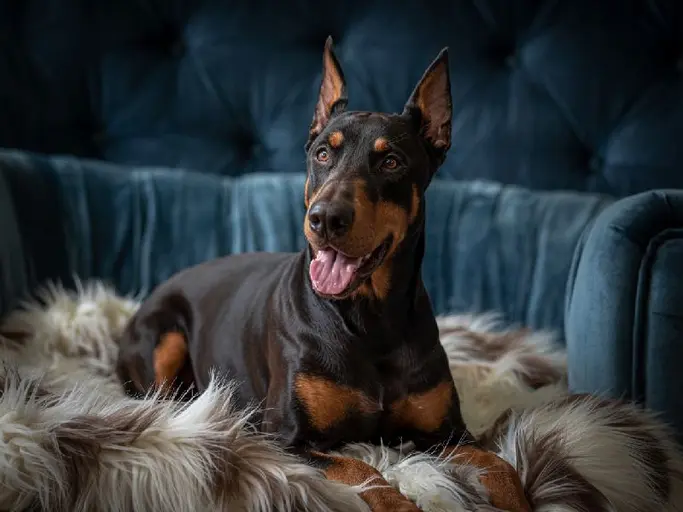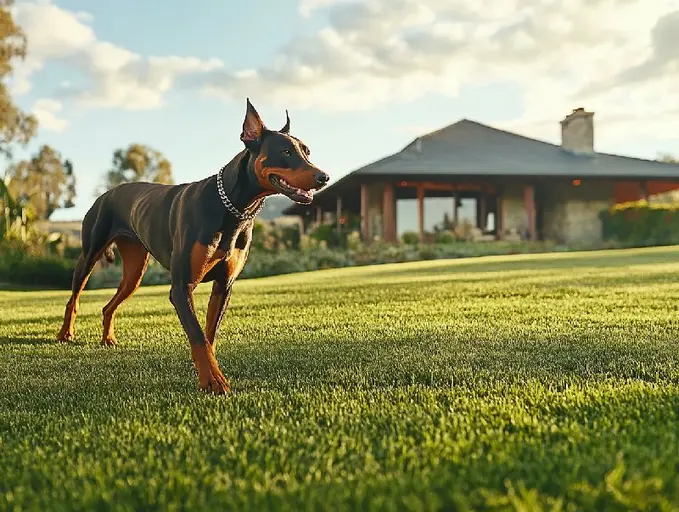The Doberman Pinscher: A Complete Breed Guide

The Doberman Pinscher is a truly striking and noble breed, known for its intelligence, athleticism, and unwavering loyalty. This breed often evokes images of sleek, powerful guardians, but there’s much more to the Doberman than meets the eye. They make wonderful companions for the right owner, offering both protection and affectionate companionship.
Brief Introduction
The Doberman Pinscher is a medium-to-large sized breed. What truly sets them apart is their elegant appearance. They are muscular and athletic, with a short, sleek coat that comes in several colors, including black, red, blue, and fawn. Their alert expression and proud carriage make them both intimidating and captivating. Beyond their physical presence they are very intelligent and trainable making them suitable for various dog sports and essential tasks.
Breed History
The story of the Doberman Pinscher begins in Apolda, Germany, around the late 19th century. Karl Friedrich Louis Dobermann, a tax collector, dog catcher, and part-time night watchman, sought to create a protective and reliable dog breed. Mr. Dobermann had a need for a dog to protect him during his often dangerous travels collecting taxes.
The Creation of a Guardian
Dobermann crossed various breeds, including the Old German Shepherd, German Pinscher, Rottweiler, and possibly the Black and Tan Terrier, to achieve his desired result. The precise mix remains unknown, but the goal was clear: a courageous, intelligent, and protective dog suitable for guarding and personal protection. Dobermann’s aim was to produce the ultimate personal protector, and he succeeded admirably.
Early Roles
Initially, Dobermans were used as personal protection dogs and guard dogs. Their intelligence and trainability quickly led to their adoption by police forces and militaries worldwide. They served valiantly in both World Wars, proving their courage and versatility in various roles. Their service dog capabilities were quickly recognized, leading to widespread adoption in law enforcement and military operations.
Appearance
The Doberman Pinscher is a well-proportioned and muscular dog breed. Their appearance is a testament to their breeding for both strength and agility.
Height and Weight
- Height: Males typically stand between 26 to 28 inches (66 to 72 cm) tall at the withers, while females are slightly smaller, ranging from 24 to 26 inches (61 to 68 cm).
- Weight: The average weight for males is between 75 to 100 pounds (34 to 45 kg), and females generally weigh between 60 to 85 pounds (27 to 39 kg).
Coat
The Doberman Pinscher has a short, dense, and smooth coat. It lies close to the body and requires minimal grooming. Recognized colors by AKC include:
- Black
- Red
- Blue
- Fawn (Isabella)
They often have rust markings on the muzzle, throat, chest, above each eye, and on the legs and under the tail.
Ears
Traditionally, Doberman ears were cropped to stand erect. However, ear cropping is becoming less common and is even illegal in some countries. Natural ears are medium-sized and hang close to the head.
Eyes
The Doberman’s eyes are almond-shaped and dark in color, reflecting their intelligence and alertness. The color should complement the coat color.
Tail
Historically, the Doberman’s tail was docked. As with ear cropping, tail docking is becoming less prevalent and is often prohibited. A natural tail is long and carried in a slight curve.
Character and Behavior
The Doberman Pinscher is often misunderstood due to their imposing appearance. However, with proper training and socialization, they can be wonderful family pets.
Attitude Towards People
Dobermans are known for their devotion to their families. They are often described as “velcro dogs” because they tend to stick close to their owners. They can be wary of strangers, making them excellent watchdogs, but they should never be aggressive without provocation. Early and consistent socialization is crucial to ensure they are comfortable around new people.
Attitude Towards Children
With proper socialization and training, Dobermans can be good with children. However, supervision is always necessary, especially with young children. It’s important to teach children how to interact respectfully with the dog and vice versa. Dobermans can be protective of children in their family, making them reliable guardians.
Attitude Towards Animals
Dobermans can be dog-friendly with other animals if raised together from a young age. However, they may exhibit dominance towards other dogs of the same sex. Careful introductions and supervision are essential when introducing a Doberman to new pets. Their high prey drive may also pose a challenge with smaller animals, such as cats or rabbits, unless properly managed.
Activity Level
Dobermans are highly energetic dogs that require plenty of exercise. Daily walks, runs, and play sessions are essential to keep them physically and mentally stimulated. They excel in dog sports such as agility, obedience, and Schutzhund (protection dog training). A bored Doberman can become destructive, so providing adequate exercise is crucial.
Trainability
Dobermans are highly intelligent and eager to please, making them relatively easy to train. They respond well to positive reinforcement methods, such as praise and treats. Consistency and patience are key, as they can be sensitive to harsh corrections. Early obedience training and socialization are essential to ensure they develop into well-behaved companions.
Breed Characteristics
- Loyalty: Dobermans are fiercely loyal and protective of their families.
- Intelligence: They are among the most intelligent dog breeds, making them quick learners.
- Courage: Dobermans are known for their courage and fearlessness.
- Energy: They have high energy levels and require plenty of exercise.
- Sensitivity: Despite their tough exterior, Dobermans can be sensitive to harsh corrections.

Care and Maintenance
Proper care and maintenance are essential to ensure the health and well-being of your Doberman Pinscher.
Care Features
The Doberman’s short coat requires minimal grooming. Regular brushing with a rubber brush can help remove loose hair and keep their coat shiny. Bathing is only necessary when they are dirty or develop an odor. Nail trimming should be done regularly to prevent overgrowth and discomfort.
Exercise
As mentioned earlier, Dobermans are high-energy dogs that need plenty of exercise. Aim for at least two hours of exercise per day, including walks, runs, and play sessions. Mental stimulation is also important, so consider incorporating training exercises and puzzle toys into their routine.
Feeding
Feed your Doberman a high-quality dog food that is appropriate for their age, size, and activity level. Follow the feeding guidelines provided by the food manufacturer, and adjust the amount as needed to maintain a healthy weight. Avoid overfeeding, as obesity can lead to various health problems. It’s best to split their daily food intake into two meals to prevent bloat, a potentially life-threatening condition.
Grooming Needs
Dobermans have low grooming requirements due to their short coat. Regular brushing will help keep their coat healthy. They also need regular teeth brushing to prevent dental disease.
Health
Dobermans are generally healthy dogs, but they are prone to certain health conditions. It’s important to be aware of these potential problems and take steps to minimize the risk.
Possible Problems
- Dilated Cardiomyopathy (DCM): A heart condition that can lead to heart failure.
- Von Willebrand’s Disease: A bleeding disorder that affects blood clotting.
- Hip Dysplasia: A malformation of the hip joint that can cause arthritis.
- Wobbler Syndrome: A neurological condition that affects the spinal cord.
- Bloat (Gastric Dilatation-Volvulus): A life-threatening condition where the stomach fills with gas and twists.
Regular veterinary checkups and genetic testing can help detect and manage these health problems.
Breed Weaknesses
While Dobermans have many positive traits, they also have some weaknesses that potential owners should be aware of.
Level of Aggression
Dobermans have a reputation for being aggressive, but this is often a result of poor breeding, training, or socialization. A well-bred and properly trained Doberman should not be inherently aggressive. However, they are naturally protective and may become aggressive if they perceive a threat to their family. Early socialization and training are crucial to mitigate any potential aggression issues.
Loyalty
While loyalty is generally a positive trait, it can also be a weakness. Dobermans are so loyal to their families that they may be overly protective and suspicious of strangers. This can make it challenging to introduce them to new people or animals. Proper socialization can help them learn to distinguish between genuine threats and harmless interactions.
Specific Weaknesses
- Sensitivity to Cold: Due to their short coat, Dobermans are sensitive to cold weather and may need a coat in cold climates.
- Prone to Separation Anxiety: Dobermans are very attached to their families and may develop separation anxiety if left alone for extended periods.
- Require Experienced Owners: Dobermans are not the best choice for first-time dog owners, as they require consistent training and socialization.
Conclusion
The Doberman Pinscher is a remarkable breed that offers intelligence, loyalty, and protection. They are best suited for experienced dog owners who can provide them with consistent training, socialization, and plenty of exercise. If you are looking for a devoted and intelligent companion, the Doberman Pinscher may be the perfect breed for you.
Frequently Asked Questions About Doberman Pinscher
-
What is a Doberman Pinscher known for?
Doberman Pinschers are known for their intelligence, athleticism, unwavering loyalty, and sleek, powerful appearance. They are excellent guardians and affectionate companions.
-
What colors do Doberman Pinschers come in?
Doberman Pinschers come in several colors recognized by the AKC, including black, red, blue, and fawn (Isabella). They often have rust markings on the muzzle, throat, chest, above each eye, and on the legs and under the tail.
-
Are Doberman Pinschers good with children?
With proper socialization and training, Doberman Pinschers can be good with children. Supervision is always necessary, especially with young children. Dobermans can be protective of children in their family, making them reliable guardians.
-
How much exercise do Doberman Pinschers need?
Doberman Pinschers are highly energetic dogs that require plenty of exercise. Aim for at least two hours of exercise per day, including walks, runs, and play sessions. Mental stimulation is also important.
-
Are Doberman Pinschers easy to train?
Doberman Pinschers are highly intelligent and eager to please, making them relatively easy to train. They respond well to positive reinforcement methods. Consistency and patience are key.
-
What are the grooming needs for Doberman Pinschers?
Doberman Pinschers have low grooming requirements due to their short coat. Regular brushing with a rubber brush can help remove loose hair. Bathing is only necessary when they are dirty.
-
What are some common health problems in Doberman Pinschers?
Some common health problems in Doberman Pinschers include Dilated Cardiomyopathy (DCM), Von Willebrand’s Disease, Hip Dysplasia, Wobbler Syndrome, and Bloat (Gastric Dilatation-Volvulus). Regular veterinary checkups are important.
-
Are Doberman Pinschers good watchdogs?
Yes, Doberman Pinschers are excellent watchdogs. They are naturally protective and wary of strangers, making them good at guarding their home and family.
-
Do Doberman Pinschers need an experienced owner?
Doberman Pinschers are not the best choice for first-time dog owners, as they require consistent training, socialization, and a firm hand. Experienced owners who understand their needs are best suited for this breed.
-
Are Doberman Pinschers sensitive to cold weather?
Due to their short coat, Doberman Pinschers are sensitive to cold weather. They may need a coat in cold climates to stay warm and comfortable.

